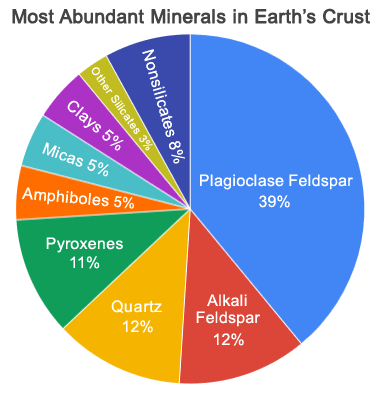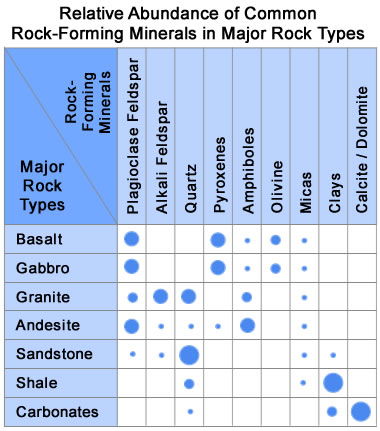Home » Minerals » Rock-Forming Minerals
The Common Rock-Forming Minerals
Most of Earth’s crust is comprised of a small number of minerals.

The Most Abundant Minerals in Earth's Crust: Known as the "common rock-forming minerals", they are minerals present at the time of a rock's formation and are important minerals in determining the rock's identity. Relative abundance percentages from Ronov and Yaroshevsky; Chemical Composition of the Earth's Crust; American Geophysical Union Monograph Number 13, Chapter 50, 1969.
What Are Rock-Forming Minerals?
Scientists have identified over 4,000 different minerals. A small group of these minerals make up almost 90% of the rocks of Earth’s crust. These minerals are known as the common rock-forming minerals.
To be considered a common rock-forming mineral, a mineral must: A) be one of the most abundant minerals in Earth’s crust; B) be one of the original minerals present at the time of a crustal rock’s formation; and, C) be an important mineral in determining a rock’s classification.
Minerals that easily meet these criteria include: plagioclase feldspars, alkali feldspars, quartz, pyroxenes, amphiboles, micas, clays, olivine, calcite and dolomite.

Rock-Forming Minerals in Major Rock Types: This chart shows the relative abundance of the common rock forming minerals in some of Earth's most abundant rock types. Basalt and gabbro account for most of the rock in the oceanic crust, granite (rhyolite) and andesite (diorite) represent abundant rock types of the continental crust. Sandstone, shale and carbonates represent the common materials in the sedimentary cover of continents and ocean basins.
Minerals of the Oceanic Crust
As an example of the influence of just a few minerals, let’s consider the rocks of the oceanic crust. The oceanic crust is mainly composed of basalt and gabbro. These two rock types are made up of mainly of plagioclase feldspar and pyroxenes, with smaller amounts of olivine, micas and amphiboles. This small group of minerals makes up most of the rocks of the oceanic crust.
Minerals of the Continental Crust
As a second example, let’s consider the rocks of the continental crust. The continental crust is made up mainly of rocks with a granitic to andesitic composition. These rocks are composed mainly of alkali feldspar, quartz, and plagioclase feldspar, with smaller amounts of amphiboles and micas. This small number of minerals makes up most of the continental crust.

The best way to learn about minerals is to study with a collection of small specimens that you can handle, examine, and observe their properties. Inexpensive mineral collections are available in the Geology.com Store. Image copyright iStockphoto / Anna Usova.
Minerals in the Sedimentary Cover
Both the oceanic and continental crusts are partly covered with a thin layer of sedimentary rocks and sediments. These consist mainly of clastic rocks such as sandstone, siltstone and shale, along with carbonate rocks such as dolostone and limestone. These clastic rocks are composed of mainly quartz, clay minerals, and a small amount of micas and feldspar minerals. The carbonate rocks consist primarily of calcite and dolomite. A small number of materials, composed of a small number of minerals, make up most of the sediment and sedimentary rocks that cover the continents and ocean basins.

Find Other Topics on Geology.com:
 | Rocks: Galleries of igneous, sedimentary and metamorphic rock photos with descriptions. |
|
 | Minerals: Information about ore minerals, gem materials and rock-forming minerals. |
|
 | Volcanoes: Articles about volcanoes, volcanic hazards and eruptions past and present. |
|
 | Gemstones: Colorful images and articles about diamonds and colored stones. |
|
 | General Geology: Articles about geysers, maars, deltas, rifts, salt domes, water, and much more! |
|
 | Geology Store: Hammers, field bags, hand lenses, maps, books, hardness picks, gold pans. |
|

|
 | Diamonds: Learn about the properties of diamond, its many uses, and diamond discoveries.
|
|




















